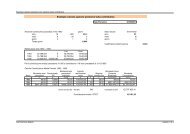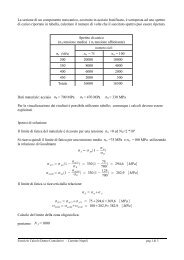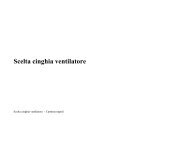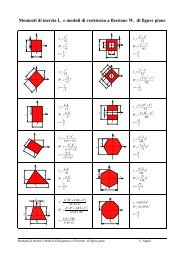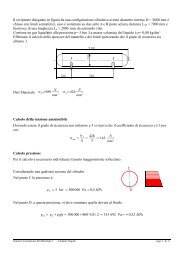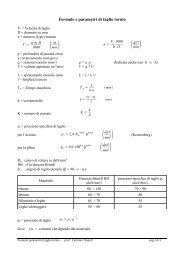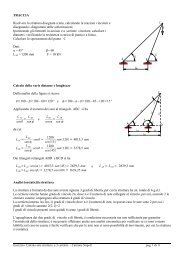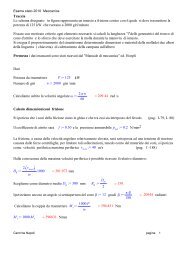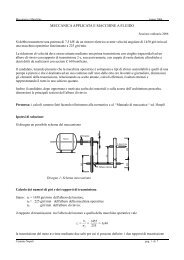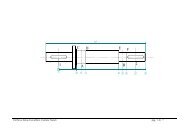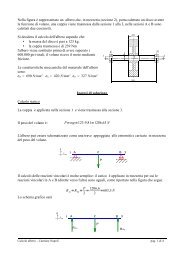Appunti sulle cinghie - Carmine - Carmnap.it
Appunti sulle cinghie - Carmine - Carmnap.it
Appunti sulle cinghie - Carmine - Carmnap.it
You also want an ePaper? Increase the reach of your titles
YUMPU automatically turns print PDFs into web optimized ePapers that Google loves.
SOLLECITAZIONE MASSIMA AMMISSIBILE<br />
La sollec<strong>it</strong>azione massima dipende da varie circostanze quali: veloc<strong>it</strong>à cinghia, periodo d’esercizio,<br />
sforzo trasmesso, tipo di manutenzione.<br />
In genere per la F am si possono assumere valori compresi tra 1/5 e 1/10 del carico di rottura.<br />
Nella tabella ci sono dei valori di riferimento<br />
PARAMETRI Carico (N/mm 2 Modulo di<br />
elastic<strong>it</strong>à E<br />
Cuoio<br />
Compos<strong>it</strong>a nylon-cuoio o<br />
elastomeri<br />
Compos<strong>it</strong>a gomma-tessuti<br />
Cotone, Balata ecc.<br />
Per alte veloc<strong>it</strong>à<br />
di rottura<br />
F r<br />
COEFFICIENTE DI ATTRITO<br />
25÷40<br />
200÷225<br />
25÷50<br />
35÷50<br />
100÷125<br />
max ammiss.<br />
F am<br />
2,5÷6<br />
25÷45<br />
2,5÷10<br />
3,5÷10<br />
10÷25<br />
N/mm 2<br />
150÷250<br />
400÷600<br />
300÷500<br />
125÷650<br />
150÷300<br />
Massa lineica<br />
specifica<br />
q 1<br />
kg/mAmm<br />
Allungamento<br />
max. sotto<br />
carico di lavoro<br />
<strong>Appunti</strong> <strong>sulle</strong> <strong>cinghie</strong> - <strong>Carmine</strong> Napoli Pag. 12<br />
1<br />
1,1<br />
1,2<br />
1,2<br />
1,1<br />
1,5÷3<br />
0,5÷1,5<br />
0,5÷2<br />
1,5÷3<br />
0,5÷1<br />
Il coefficiente di attr<strong>it</strong>o fra cinghia e puleggia dipende dalle superfici di contatto, e aumenta<br />
all’aumentare della veloc<strong>it</strong>à, per <strong>cinghie</strong> di cuoio su pulegge di ghisa vale f=0,22 +0,12v<br />
mentre per <strong>cinghie</strong> compos<strong>it</strong>e su pulegge di acciaio si ha<br />
Dipende infine dalla temperatura, dall’umid<strong>it</strong>à e dalle condizioni di esercizio.<br />
Nella tabella che segue sono riportati alcuni valori.<br />
Materiale delle <strong>cinghie</strong><br />
Cuoio a concia vegetale<br />
Cuoio a concia minerale<br />
Gomma<br />
Tessuto gommato<br />
Balata<br />
Cotone<br />
(1) Pulegge pul<strong>it</strong>e<br />
(2) Pulegge umide<br />
(3) Pulegge con tracce d’olio<br />
(4) Pulegge con tracce di grasso<br />
Materiale delle pulegge<br />
Legno Acciaio o ghisa<br />
0,30<br />
0,45<br />
0,35<br />
0,38<br />
0,35<br />
0,25<br />
0,25<br />
0,40<br />
0,32<br />
0,35<br />
0,32<br />
0,22<br />
(1) (2) (3) (4)<br />
0,20<br />
0,35<br />
0,15<br />
0,20<br />
0,20<br />
0,15<br />
0,12<br />
0,20<br />
0,10<br />
0,15<br />
0,25<br />
0,12



